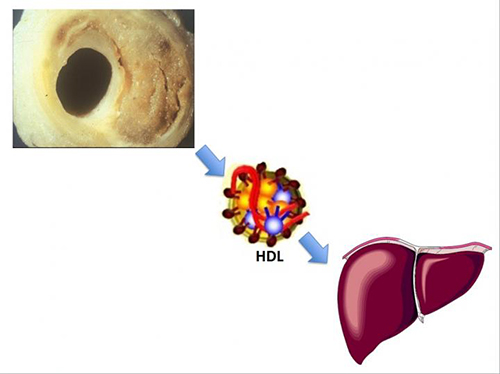![HDL, or “good” cholesterol, can remove cholesterol from arteries and shuttle it to the liver where it is eliminated, but this process can be disrupted in certain circumstances. For example, a variant form of the SCARB1 gene may destroy HDL receptor function. This variant has been associated with both elevated HDL cholesterol and a higher risk of heart disease. [Laboratory of Daniel Rader, M.D., Perelman School of Medicine, University of Pennsylvania]](https://genengnews.com/wp-content/uploads/2018/08/Mar11_2016_UnivPenn_HDL1781154723-1.jpg)
HDL, or “good” cholesterol, can remove cholesterol from arteries and shuttle it to the liver where it is eliminated, but this process can be disrupted in certain circumstances. For example, a variant form of the SCARB1 gene may destroy HDL receptor function. This variant has been associated with both elevated HDL cholesterol and a higher risk of heart disease. [Laboratory of Daniel Rader, M.D., Perelman School of Medicine, University of Pennsylvania]
It turns out that high-density lipoprotein (HDL) cholesterol, or “good cholesterol,” may not do you any good, even if it is perfectly formed, even if it is circulating at high levels in your blood, and even if forms particles swollen with cholesterol scrubbed from artery walls. HDL cholesterol particles can circulate and circulate and circulate, and never securely dock with receptors in the liver, never deposit their cholesterol loads for elimination, and never adequately protect against heart disease.
The rub, according to scientists at the University of Pennsylvania, is in the docking—or rather the lack of it. These scientists, led by Daniel J. Rader, M.D., report that HDL cholesterol can do little good if it must struggle to dock with flawed HDL receptors in the liver.
The HDL receptor, which is known as the scavenger receptor B1 (SR-B1), is ill-formed, and ill-functioning, if is encoded by a variant form of the SCARB1 gene. This finding may help explain why HDL-raising drugs have shown little or no benefit, even though HDL cholesterol has been associated with decreased risks of coronary heart disease.
“The thinking about HDL has evolved recently to the concept that it may not directly protect against all heart disease,” said Dr. Rader. “Our results indicate that some causes of raised HDL actually increase risk for heart disease. This is the first demonstration of a genetic mutation that raises HDL but increases risk of heart disease.”
Dr. Rader’s team described their work in an article (“Rare Variant in Scavenger Receptor BI Raises HDL Cholesterol and Increases Risk of Coronary Heart Disease”) that appeared March 1 in Science. The article described how the team sequenced the coding regions of lipid-modifying genes in 328 individuals with extremely high plasma HDL cholesterol levels.
“[We] identified a homozygote for a loss-of-function variant, in which leucine replaces proline 376 (P376L), in SCARB1, the gene encoding SR-BI,” wrote the study’s authors. “The P376L variant impairs posttranslational processing of SR-BI and abrogates selective HDL cholesterol uptake in transfected cells, in hepatocyte-like cells derived from induced pluripotent stem cells from the homozygous subject, and in mice.”
The researchers discovered that persons who carry only one copy of the SCARB1 P376L mutation have significantly higher HDL-C levels. From this, Dr. Rader and colleagues formed a hunch, based on their knowledge of SCARB1 function and previous studies in mice, that having the SCARB1 P376L mutation, despite raising HDL, might paradoxically increase the risk of heart disease.
Working with other researchers around the world, the Penn team was able to show exactly what they had surmised. “This SCARB1 variant, while rare, is just frequent enough that it allowed us to ask the question about its effect on HDL and heart disease in people with only one copy of the mutation,” Dr. Rader explained.
The Penn team and their colleagues plan to characterize and test other SCARB1 mutations for their relationship to HDL levels and heart disease. Other genes may also have similar effects. “Eventually we may want to perform genetic testing in persons with high HDL to make sure they don't have mutations—like this one—that raise HDL but don't protect against, or may even increase, risk for heart disease,” Dr. Rader noted. Since the P376L mutation in SCARB1 appears to be specific to people of Ashkenazi Jewish descent, testing in this ethnic group might be particularly important.
Dr. Rader suggests that a therapeutic approach to increase the expression or activity of SCARB1 could be a new way to reduce the risk of heart disease even though it would reduce HDL blood levels. “The work demonstrates that the protective effects of HDL are more dependent upon how it functions than merely how much of it is present,” Dr. Rader concluded. “We still have a lot to learn about the relationship between HDL function and heart disease risk.”



